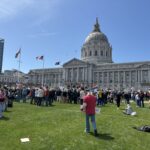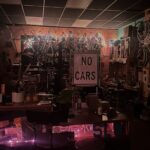In the United States in the 1960s, there were many large-scale anti-war protests. Many Americans were shocked by the violence and intensity of the Vietnam War. Some Americans opposed the war because they believed the war threatened Vietnamese independence, and others opposed it because they thought the war was unwinnable. Others believed the war supported an autocratic and corrupt regime. Additionally, the assassination or Martin Luther King and the nomination for Robert Kennedy to be the president of the United States created great social turmoil. San Francisco was much more “segregated, both economically and socially and culturally and racially than it is today.” San Francisco had a large Irish population until it became more diverse after World War II after becoming increasingly industrial and urban. The city attracted many African American people who came from the South. 18,000 Japanese Americans were in internment camps in San Francisco while the U.S. was at war with Japan. With China as an ally, Chinese Americans gained greater respect in U.S. communities and obtained job opportunities more easily. After the Chinese and Japanese immigrants who immigrated during the war, Mexican and Central American immigrants replaced the large SF Irish population. With more minority representation in San Francisco, local politics became increasingly liberal.
Robert Sanborn, current photography and contemporary media & art instructor at LWHS since 1988, graduated from LWHS in 1974. Sanborn stated that LWHS was more diverse in comparison to San Francisco, He stated that at LWHS, he “bumped up against people who were who are not, who are not like the people that I that I see the family of origin and or the, the social group that my parents were connected with”. He continued and stated “it was really a place where [he] learned about different aspects of the city and culture.”
Sanborn began as an LWHS student in 1966 when LWHS was tuition free and an all-boys institution. The architecture models and displays in the LWHS window at the entrance initially attracted Sanbron to LWHS. Sanborn was compelled by the school’s “real grounding in the industrial and technical arts”. At LWHS, Sanborn immersed himself in and took advantage of the strong technical and visual arts programs. He particularly enjoyed the “practically-oriented shops classes” and states that the machine shops class was one of his toughest classes. Sanborn explained that at the time, the shops were “more trade oriented” which meant thatone could learn skills that they could make a living in. Sanborn states that “the emphasis was not on design, and fabrication and creativity it was on learning these skills for the purposes of professional work.” Sanborn especially enjoyed LWHS’ rich drawing and painting program. Before coming to LWHS, Sanborn had an ardent passion for photography. Sanborn learned how to develop and print film in a public darkroom owned by the SF City and County’s Parks and Recreation Department. LWHS’s first photography class commenced in Sanborn’s senior year. Generally, LWHS opened up “not just educational possibilities, but philosophical outlook and or looking at the world in a very, very different way than [he] had been experiencing before”. Additionally, Sanborn described that the teachers at LWHS in the 60’s were eccentric and individualistic. He stated that they were all incredibly passionate about what they were teaching. Sanborn describes that he struggled “with chemistry, but to watch the chemistry teacher get excited about chemistry was like a revelation.”
The LWHS mission statement of “head, heart, and hands” focuses on integrating sciences, liberal, visual, and technical arts in order to prepare students for the world. Sanborn stated that the teachers at LWHS do a good job of supporting each student as an individual and that the art programs nurture passions for creativity.
After LWHS, Sanborn worked in photography, furniture repair and restoration. Sanborn began working at LWHS to reconnect with the community. Sanborn stated that “teaching seemed like a really interesting way to share the knowledge that I picked up in the actual practical fields and teach that way as opposed to teaching from teaching college preparation.” The curriculum that Sanborn teaches comes from his work experiences rather than college degree programs.






